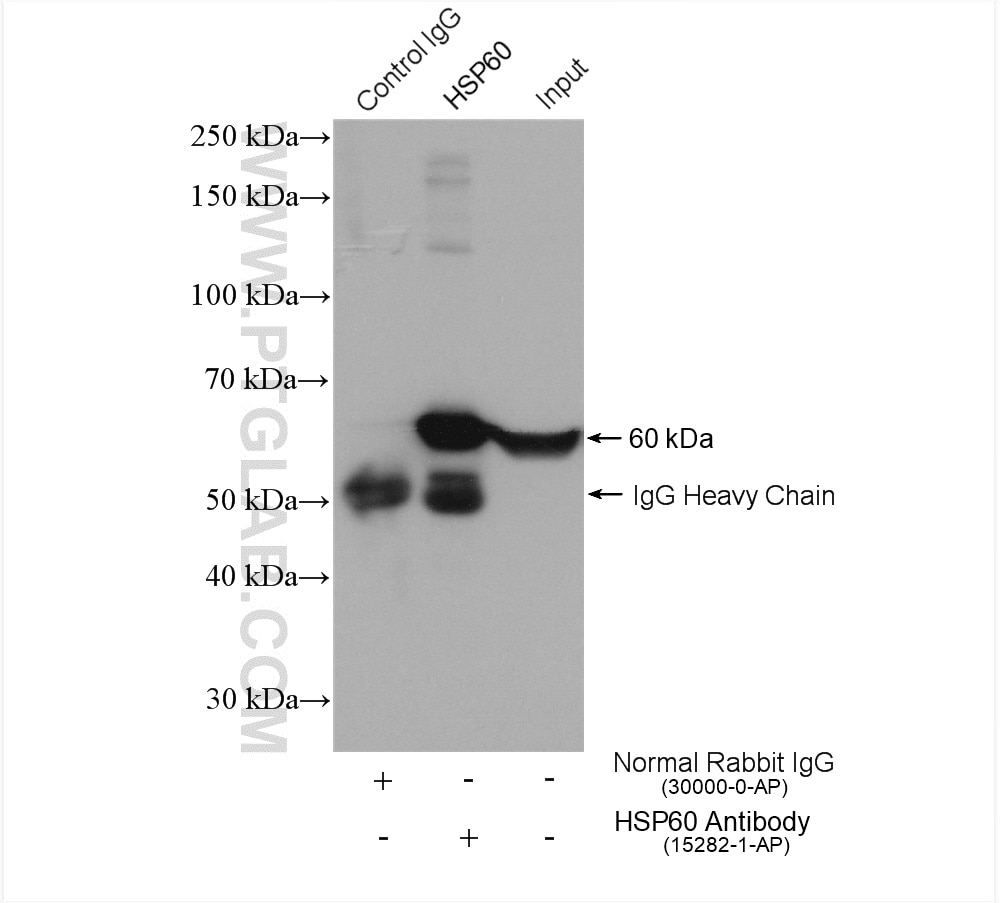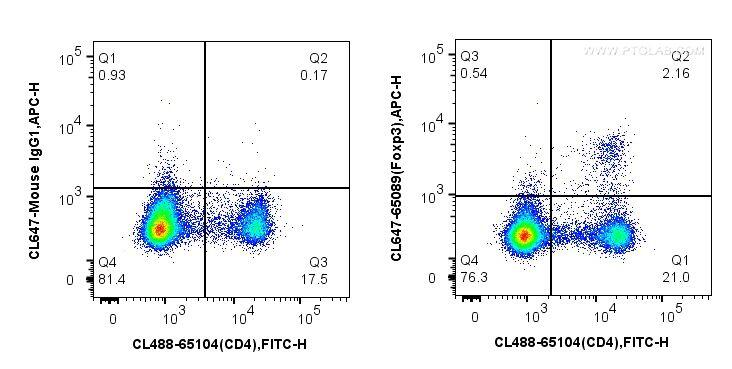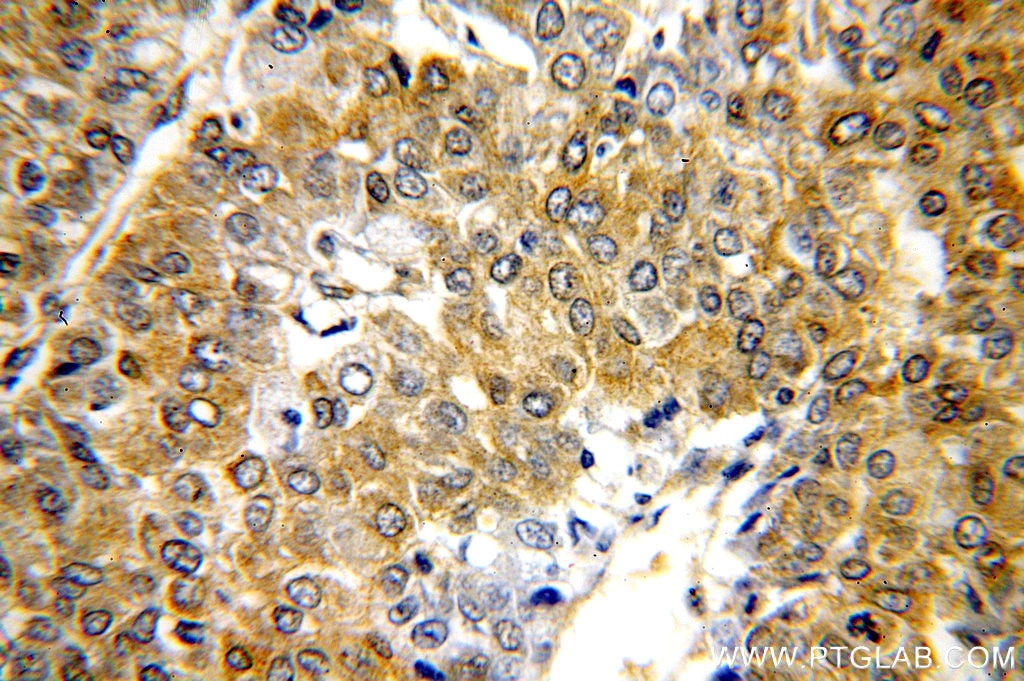- Phare
- Validé par KD/KO
Anticorps Polyclonal de lapin anti-HSP60
HSP60 Polyclonal Antibody for WB, IHC, IF/ICC, FC (Intra), IP, ELISA
Hôte / Isotype
Lapin / IgG
Réactivité testée
Humain, rat, souris et plus (8)
Applications
WB, IHC, IF/ICC, FC (Intra), IP, CoIP, ELISA
Conjugaison
Non conjugué
125
N° de cat : 15282-1-AP
Synonymes
Galerie de données de validation
Applications testées
| Résultats positifs en WB | cellules HEK-293, cellules HepG2, cellules NIH/3T3, cœur de rat, cœur de souris, HeLa |
| Résultats positifs en IP | cellules HEK-293, |
| Résultats positifs en IHC | tissu de cancer du poumon humain, il est suggéré de démasquer l'antigène avec un tampon de TE buffer pH 9.0; (*) À défaut, 'le démasquage de l'antigène peut être 'effectué avec un tampon citrate pH 6,0. |
| Résultats positifs en IF/ICC | cellules HeLa, |
| Résultats positifs en FC (Intra) | cellules HepG2, |
Dilution recommandée
| Application | Dilution |
|---|---|
| Western Blot (WB) | WB : 1:2000-1:16000 |
| Immunoprécipitation (IP) | IP : 0.5-4.0 ug for 1.0-3.0 mg of total protein lysate |
| Immunohistochimie (IHC) | IHC : 1:50-1:500 |
| Immunofluorescence (IF)/ICC | IF/ICC : 1:50-1:500 |
| Flow Cytometry (FC) (INTRA) | FC (INTRA) : 0.40 ug per 10^6 cells in a 100 µl suspension |
| It is recommended that this reagent should be titrated in each testing system to obtain optimal results. | |
| Sample-dependent, check data in validation data gallery | |
Applications publiées
| KD/KO | See 2 publications below |
| WB | See 102 publications below |
| IHC | See 7 publications below |
| IF | See 26 publications below |
| IP | See 1 publications below |
| ELISA | See 1 publications below |
| CoIP | See 1 publications below |
Informations sur le produit
15282-1-AP cible HSP60 dans les applications de WB, IHC, IF/ICC, FC (Intra), IP, CoIP, ELISA et montre une réactivité avec des échantillons Humain, rat, souris
| Réactivité | Humain, rat, souris |
| Réactivité citée | rat, bovin, Humain, levure, poisson-zèbre, porc, poulet, riz, souris, duck, fish |
| Hôte / Isotype | Lapin / IgG |
| Clonalité | Polyclonal |
| Type | Anticorps |
| Immunogène | HSP60 Protéine recombinante Ag7401 |
| Nom complet | heat shock 60kDa protein 1 (chaperonin) |
| Masse moléculaire calculée | 61 kDa |
| Poids moléculaire observé | 60 kDa |
| Numéro d’acquisition GenBank | BC003030 |
| Symbole du gène | HSP60 |
| Identification du gène (NCBI) | 3329 |
| Conjugaison | Non conjugué |
| Forme | Liquide |
| Méthode de purification | Purification par affinité contre l'antigène |
| Tampon de stockage | PBS avec azoture de sodium à 0,02 % et glycérol à 50 % pH 7,3 |
| Conditions de stockage | Stocker à -20°C. Stable pendant un an après l'expédition. L'aliquotage n'est pas nécessaire pour le stockage à -20oC Les 20ul contiennent 0,1% de BSA. |
Informations générales
HSPD1, also known as HSP60, belongs to the chaperonin family and acts as a chaperone to enhance cell survival under physiological stresses. Hsp60 has been shown to be connected with many aspects of cell functions such as protein folding and assembling of polypeptide chains in mitochondria. Recently it has been reported that HSP60 is associated with apoptosis or inhibition of cancer cell growth. (21822415)
Protocole
| Product Specific Protocols | |
|---|---|
| WB protocol for HSP60 antibody 15282-1-AP | Download protocol |
| IHC protocol for HSP60 antibody 15282-1-AP | Download protocol |
| IF protocol for HSP60 antibody 15282-1-AP | Download protocol |
| IP protocol for HSP60 antibody 15282-1-AP | Download protocol |
| Standard Protocols | |
|---|---|
| Click here to view our Standard Protocols |
Publications
| Species | Application | Title |
|---|---|---|
Nucleic Acids Res RNase H1 facilitates recombinase recruitment by degrading DNA-RNA hybrids during meiosis | ||
J Hazard Mater Long-term effect of PBDE-99 prenatal exposure on spermatogenic injuries via the dysregulation of autophagy | ||
Nat Commun Endonuclease G promotes autophagy by suppressing mTOR signaling and activating the DNA damage response. | ||
Nat Commun Prohibitin 1 is essential to preserve mitochondria and myelin integrity in Schwann cells. | ||
Nat Commun EGFL9 promotes breast cancer metastasis by inducing cMET activation and metabolic reprogramming. |


















